Landing leads: The beginner’s guide to landing page design
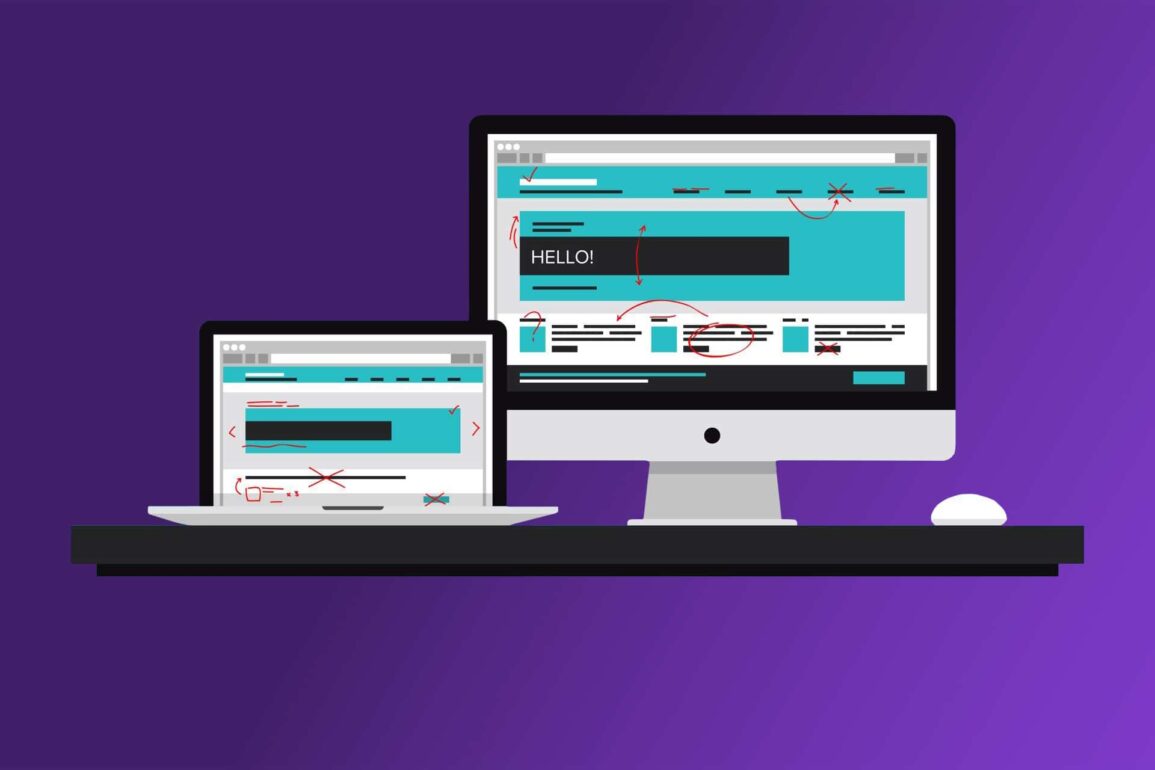
Want to make a profit online?
One of the things you’ll definitely need is a great landing page.
Landing page design and lead capture forms are critical to the process of lead generation. For business beginners, ‘leads’ are potential customers. Without leads and the processes you use to create them, marketers and companies alike would struggle to make any money from their online presence.
Unlike a standard homepage, landing pages allow you to direct your website visitors to specifically targeted pages designed to get them feeling confident about your brand and taking action. Landing pages also push visitor attention towards a specific offer, which means that they’re less likely to get distracted and go elsewhere.
Of course, converting your everyday website visitors into leads is hard work – even if you’ve got the power of a great landing page. Fortunately, we’ve put together a few quick tips for landing page design that should generate bigger returns from your digital marketing campaigns.
Get ready for a smooth landing.
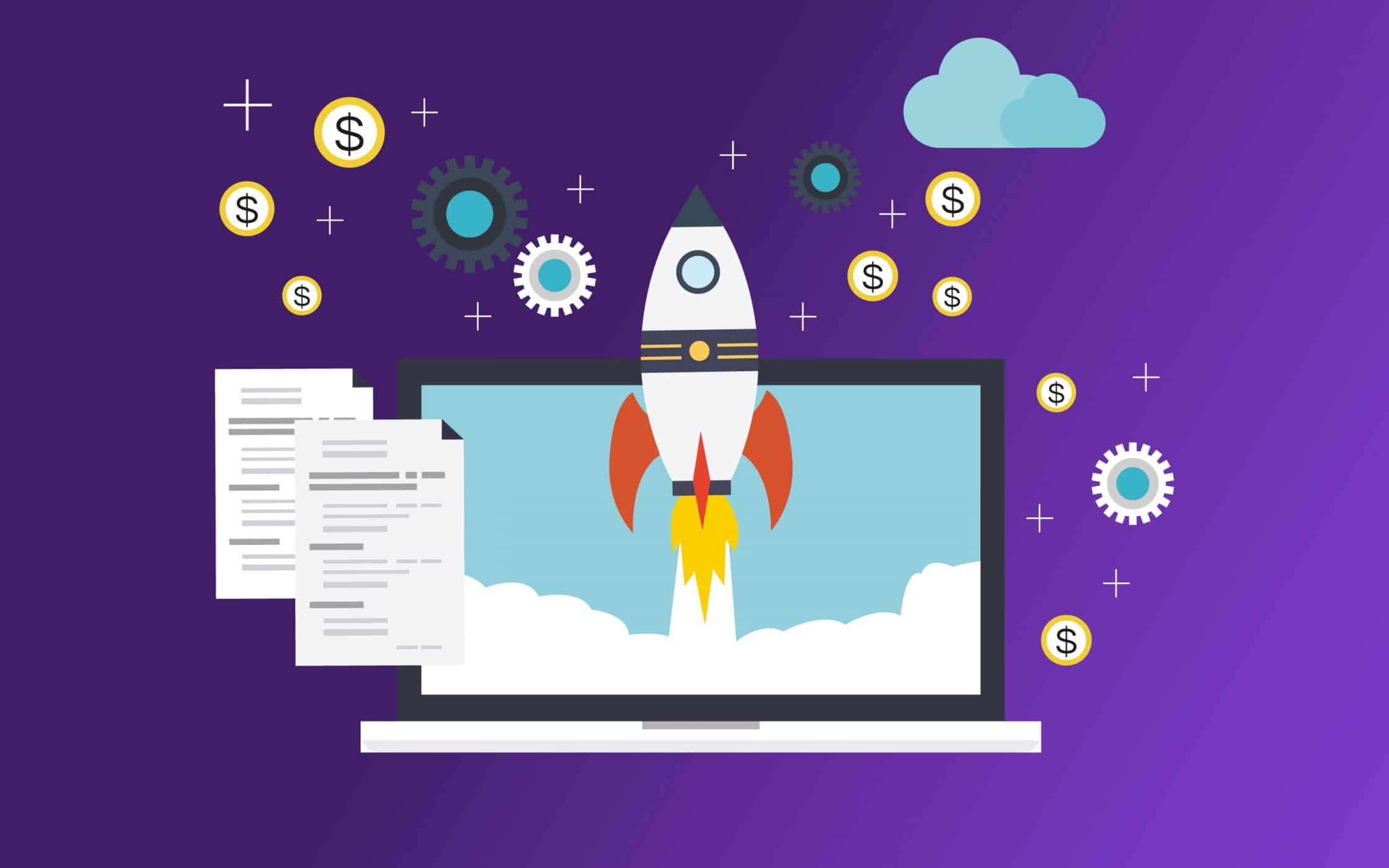
Getting ready to land: What is a landing page?
Before you can start making the most of landing page inspiration, you need to answer one simple question: “What is a landing page?”
There are so many complex terms used in the digital world these days that it’s tough to keep track. Essentially, a landing page is a critical part of your online presence, intended to help you capture visitor information through ‘lead’ forms.
Effective landing page design involves adjusting your pages to suit a specific stream of traffic. Since today’s customers prefer offers that seem tailor-made to their needs, the more targeted your landing page is, the more effective it should be.
Landing pages can be an incredible way to capture leads, by focusing on a specific goal and showcasing your value in a powerful, unique way. The people who visit your landing pages will already be interested enough in your brand and product that they felt comfortable clicking your link. This means that if you can get your landing page design right, then you’re well on your way to a sale.
Overall, landing pages help companies to connect with customers and keep them interested in a brand that they already find enticing. So, the question is, what makes a good landing page?

What makes a good landing page?
Most digital marketing and business experts agree that a high-converting landing page is a crucial component in any online campaign. After all, good landing page design turns visitors into leads and customers. However, there’s a good chance that you’ve seen your share of terrible landing pages over the years. That’s because many companies know they need a landing page, but they don’t know how to create one that resonates with their customers.
Like any other element of your online presence, your landing page is part of your brand identity. Use the right images, copy, and formatting, and you’ll remind your clients that they’re working with an organisation that feels familiar and reliable. Get your design wrong, and you could ruin your reputation forever.
No pressure.
To help take some of the stress off your shoulders, here are some landing page tips to guide you through your first creations.
1. Know your goals
Any marketing effort needs a goal. Whether it’s a referral marketing campaign or a social media strategy, you need a way to determine whether your plan is successful or not. Do you want people to sign up for your email newsletter, call your service team, or simply buy something from your eCommerce store?
Once you know your goals, you can begin to align them with the goals of your customers. For instance, if you want people to sign up for an email newsletter, then you’ll need to expect that those customers want something in return – like plenty of entertainment, discounts, and information.
2. Get the headline right
When it comes to landing page design best practices, there are few things more important than a great headline. Typically, sensational headlines should be short and sweet. The experts over at Kissmetrics recommend somewhere between 6 to 12 words.
Ultimately, the most important aim with any landing page headline is to let your visitor know what they can get from you on that page. Headlines need to be descriptive, authentic, and interesting, for example:
- Exclusive guide to brand refreshes and rebranding.
- How to improve your web design for better traffic.
- Brand strategy tips: Time to invest in your biggest asset?
Look at the Uber heading for instance:

Remember that your subheadings throughout the web page copy need to be compelling too. This is the content that will help to guide people down your page, towards your call-to-action.
3. Address the obvious question
Often, the answer to “What makes a good landing page” starts by looking at the page’s ability to answer one simple question: “What’s in it for me?” You know why you’re spending your time on landing page design—to get leads and conversions—but what do your customers get out of it?
Examine your target audience carefully and think about what you can give them that would increase their willingness to convert. For instance, would a B2B customer happily hand over their email address in exchange for an eBook that could improve their profits? Would a B2C client convert in exchange for a free gift or discount code? When you know what your customers want from you, you can design ‘lead magnets’ that convince them to click on your links and move further through the sales funnel.
4. Highlight your call-to-action
Unlike a homepage which welcomes people to your website and gives them some basic information about your brand, landing page design is all about convincing people to act. A good opt-in page or landing page needs something that tells people what they need to do next when they arrive on your site, that’s where your ‘CTA’ or call-to-action comes in. Make sure you:
- Use a contrasting colour to draw attention to the button: Your call-to-action button shouldn’t blend in with the rest of your website page. Make sure that it grabs a visitor’s attention instantly.
- Make it personal: Your customers will approach your landing page from a “What’s in it for me” perspective. Changing your wording to address the client with something like “Send me the list” instead of “Get the list” can increase conversions.
- Use powerful words: While you need to keep your call-to-action short and simple, you also need to choose the right words. Stay away from any emotionless single words like “Download” or “Submit.”
Check out this toolkit page by Optimizely for a great example of CTA design done right:
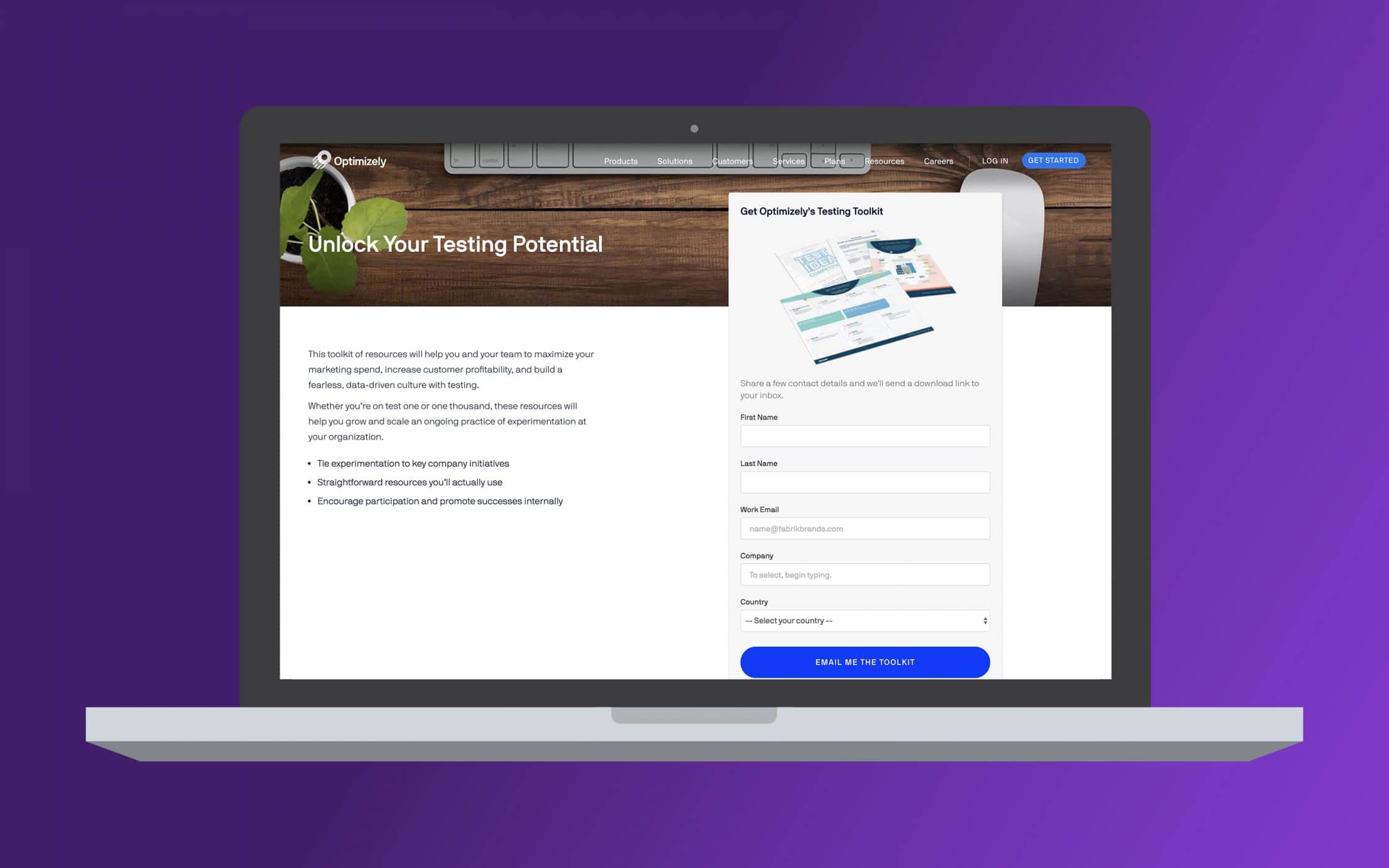
5. Give plenty of information, but don’t ask for much back
The balance of what you give to your audience, and what you get in return has to be somewhat uneven with landing page design. You’ll need to provide plenty of insight into what you can offer your audience, and what you would like them to do in exchange for your offer. However, you can’t ask for much back on your opt-in forms.
While it’s tempting to ask for plenty of data that you can use to supplement your user personas, remember that you’re still dealing with uncertain people at this stage of the buyer journey. They need to feel as though the reward they get from signing up with you is bigger than the risk. With that in mind, don’t make your form too invasive. Keep it short, simple, and only ask for the information you absolutely need.
Landing the look: Landing page design best practices
Achieving the right landing page design involves getting the perfect blend of creativity and information onto a single page.
The best landing page examples typically have no extraneous links, no navigation to worry about, and no other distractions, because the ultimate goal is to help a visitor convert fast. If you give your prospects other options besides following your call-to-action, then you won’t get the best conversion rate.
1. Eliminate navigation elements
Navigation elements are a basic component of great website design. However, when it comes to landing page design, you need to make the page as simple and focused as possible. This means that the only clickable links on your page should be a call-to-action, and possibly a link to extra information for nervous customers.
The internet is a great place for customers to get distracted, so make it easier for them to maintain their focus on your page. Too many options on your landing page design ensure that people will leave your site without converting.
2. Get the critical components right
Throughout the history of graphic design, there have always been critical components for creative minds to think about. Landing page design is no different. Here are just a few landing page design best practices to think about:
- Colour: The psychology of colour plays more into your customer’s choices than you may realise. For instance, while soft blues offer a sense of trust and credibility, red and orange are stimulating and energetic – making them ideal for certain companies and CTA buttons.
- White space: Filling every inch of your page with design elements is never a good idea. Most experts know that whitespace is critical to enhancing certain elements of your page and ensuring that your content is easy to read.
- Imagery: The right graphics can help to give context to your message and demonstrate your value in a very clear way. Additionally, images help to break up your text so that your customers don’t feel too overwhelmed. You can even add video to increase your conversion rates by as much as 86%!

3. Make sure your pages work anywhere
Most companies today know that if they want their promotional strategies to work, they need their pages to perform on both desktop and mobile devices. However, when it comes to figuring out what makes a good landing page, it’s important to remember that your designs need to not only show up on mobile but work perfectly too.
Content needs to be easy-to-read, videos should load in seconds, and call-to-action buttons must be simple to click on, all with a much smaller screen to contend with. Remember, Google tells us that 53% of visitors on a mobile site will leave after 3 seconds if the page doesn’t load fast enough.
4. Ensure your visuals make an impact
As mentioned above, the right visuals can have real value on a landing page. We all love seeing the thing we’re about to buy or invest in. Before your customers give up their personal information, they want to know what they’re going to get in return. For example, if you’re using an eBook as your lead magnet, make sure your visitors can see a preview of the cover.
If you’ve got enough space to play with, without making your landing page too cluttered, you can also consider introducing things like brand photography and other elements from your visual identity. However, remember that above all else, your landing pages should be simple, streamlined and straightforward.
5. Pack in ‘proof’ elements
We’re living in a world full of cynical customers who are sick of con artists and spam online. Landing page design best practices often involve methods you can use to overcome this sense of cynicism and give your clients the extra credibility they need. You can develop consumer trust by:
- Adding a privacy message: By way of a link to your privacy policy showing your customers how their information is used – this is critical in today’s GDPR-focused world.
- Including security seals: Better Business Bureau ratings, and certifications. An SSL certificate on your website, like a wildcard SSL is essential to secure your primary and first level sub domains. There are a range of popular products, such as a RapidSSL Wildcard Certificate, to help you get a handy green padlock for your landing page design.
- Providing testimonials and reviews: New customers love social proof. Sharing reviews with pictures of previous customers is a great way to demonstrate your value. If you’re a B2B company, you can even show the logos of other brands you’ve worked with.

Landing page tips for a quicker conversion
At this point, you should be set up for a pretty solid landing with your opt-in pages.
Of course, it’s important to remember that there’s no one-size-fits-all solution to conversions. As you continue to learn more about your customers and their preferences, you’ll develop your own list of landing page design best practices. In the meantime, here are a few additional landing page tips to spruce up your strategies, and engage your customers:
1. Use clear, concise copy
There are a lot of technical elements involved in good landing page design. However, that doesn’t mean you should overlook the creative side of your campaigns. Your copy needs to be concise, clear, and persuasive. Landing pages need to enlighten and engage your audience, without being so complex that your customers don’t understand what they’re going to get from you.
Use your landing page copy to remind your audience of your reputation, and why they clicked on your link in the first place. Remember, your purpose here is to drive people towards making a decision, so every word you choose should be persuasive and positive.
2. Maintain your tone and personality
Designing a landing page is so different to designing any other page for your website, that it can feel like a completely disconnected process. In fact, some people get so immersed in the unique nature of landing page design, that they forget to maintain a consistent tone and personality to properly demonstrate their brand.
Unfortunately, losing sight of your brand image can mean that you create a landing page that feels detached from your organisation, and unable to resonate with your audience. Your clients want to know that they’re still interacting with you when they land on your opt-in pages. With that in mind, make sure that you maintain your unique tone of voice and personality. Even making sure that you use the same brand colours and design elements can be helpful here.
3. Split test and evaluate your landing pages
Finally, if you really want to make the most out of your landing pages, then you need to track and optimise their performance. A split test or A/B test is often the best option here. When you conduct a split test, you serve half of your incoming traffic a control version of your landing page, while the other half gets a version with a small change.
A/B testing should only focus on one change at a time so that you can track results efficiently. For instance, you might look at:
- Your headline.
- Your call-to-action text.
- Your call-to-action button (colours, size, location).
- Your internal copy.
Every time you A/B test your page it should become more effective, as you can consistently learn what your customers like best.

Landing page inspiration: 3 great landing page examples
Convincing visitors to take the plunge and sign up for your email newsletter or convert into a customer isn’t easy.
There are so many elements involved in landing page design best practices that it’s easy to get overwhelmed. While a branding and design company can help to make the process a little simpler for you, it’s always useful to take a look at the landing pages that came before too, for an insight into which features work. Here are just 3 landing page examples to help with your inspiration.
Landing page inspiration 1: Wistia
Wistia’s free account landing page is simple, short, and ready to convert. There’s no additional information because the company assumes that you already know enough about its services if you’ve ended up on the landing page. The form length is short, and the CTA button uses a bright, but unique colour to draw attention. What’s more, Wistia has maintained their familiar design pattern in the background to remind you of who you’re connecting with.
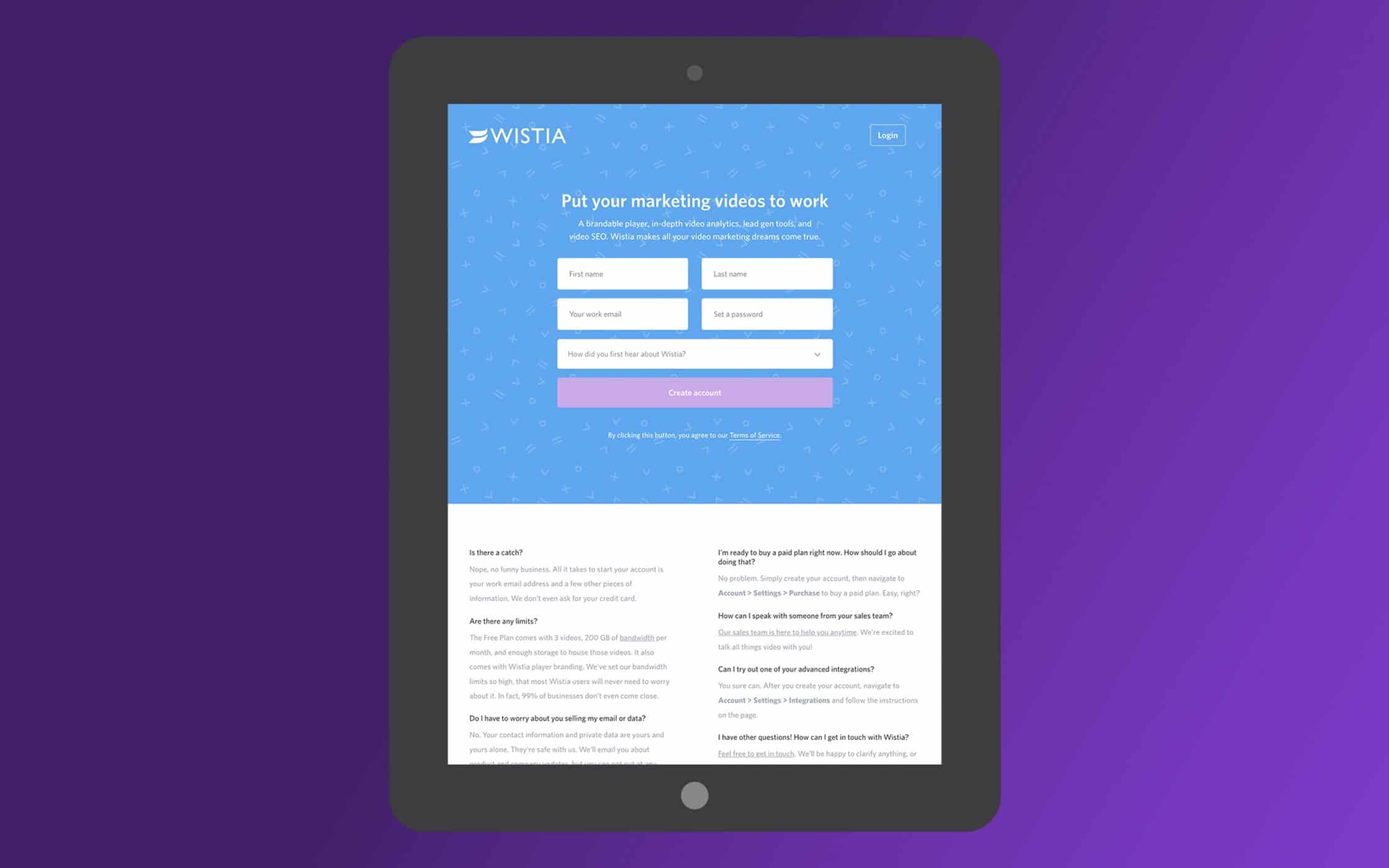
Underneath the call-to-action, you’ll find FAQ information linking out to important pages in case you do need any extra information before you’re ready to convert. By placing all the important conversion details above the fold, Wistia has made it incredibly easy to engage their audience.
Landing page inspiration 2: Bills.com
When it comes to converting customers, there are few things more effective than showing them you understand their issues and pain points. Personalised landing pages are a great way to differentiate yourself from other organisations in your niche and remind your clients that you think of them as more than just a number. Bills.com starts their landing page with some basic privacy information, and the option to choose your debt amount:
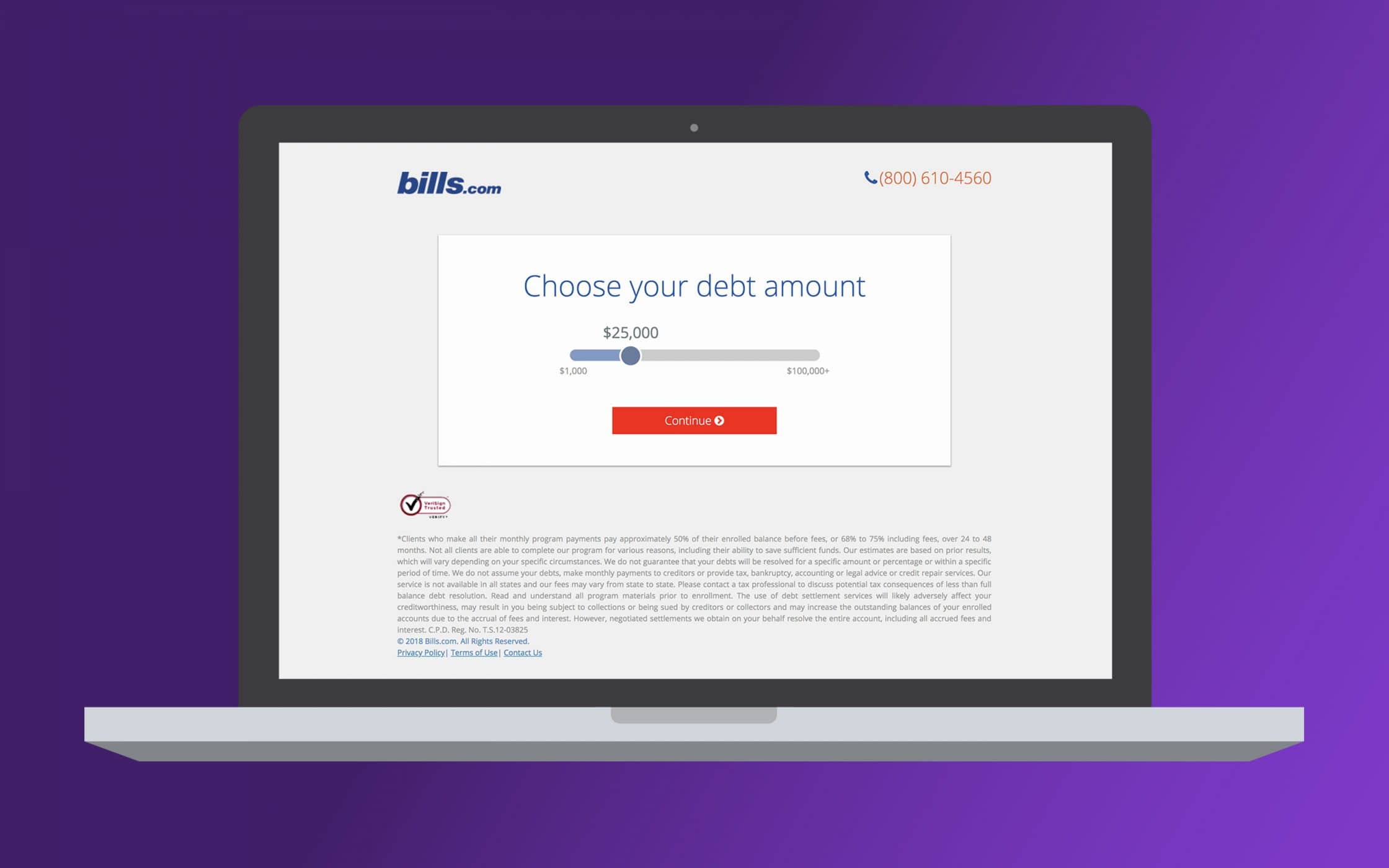
After you click ‘continue’ you can confirm whether you’re behind on your payments, which state you live in, and provide your email address to get a simple insight into what kind of help you can get from the company. The landing page is immersive, interactive, and designed exclusively for the individual.
Landing page inspiration 3: Teambit
Finally, Teambit, an HR software company, offer a unique solution for those in search of landing page design best practices. The company maintains their engaging personality by adding playful illustrations to the content to help guide customers through the landing page. The CTA appears above the fold on the page, so that you can either sign up instantly or scroll through the rest of the page to get more information.

Additionally, Teambit stands out because it gives you the option to choose how you want to sign up. This instantly makes the service feel more personalised and flexible.
Ready to leverage landing page design?
No matter how you slice it, landing pages are valuable marketing tools capable of benefitting any kind of business. Whether you’re looking for a way to enhance your email marketing list, or you want to sell more through your eCommerce site, a landing page can help.
Unlike website homepages, which generally provide an in-depth overview of your business, landing pages can help you to and boost your profits through stellar campaigns and unique audience insights.
While a poorly-designed landing page can push prospects to abandon your company before they’ve even had a chance to consider your offer, the right design can be incredibly valuable. Optimising your landing page with the landing page design best practices mentioned above will give you more access to happy customers, plenty of powerful conversion information, and the funnel you need to promote bigger profits.
Enjoy a safe landing.
If you enjoyed this article, you might enjoy these too:
— Promotional practices to perfect your online presence
— Help me help you: Why brands need a knowledge base











